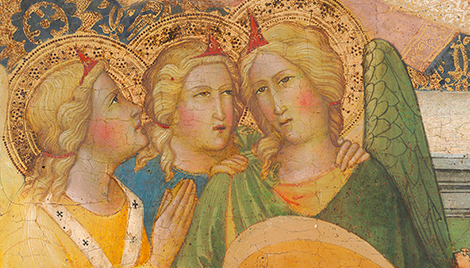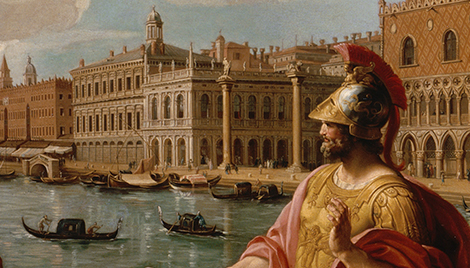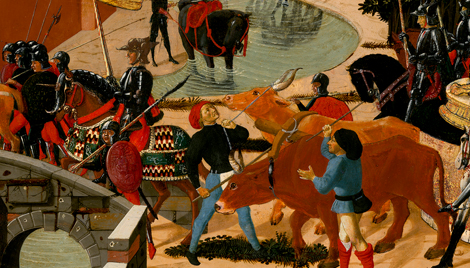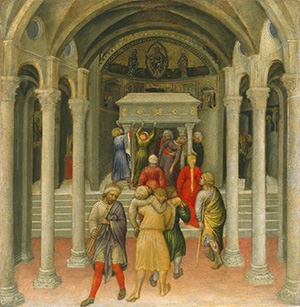The Crippled and Sick Cured at the Tomb of Saint Nicholas
The Crippled and Sick Cured at the Tomb of Saint Nicholas
- Artist
- Gentile da Fabriano
- Artist Dates
- c. 1370-1427
- Artist Nationality
- Italian
- Title
- The Crippled and Sick Cured at the Tomb of Saint Nicholas
- Date
- 1425
- Medium
- tempera on panel
- Dimensions
- painted surface: 35.5 x 35.5 cm (14 x 14 in)
- K Number
- K486
- Repository
- National Gallery of Art
- Accession Number
- 1939.1.268
- Notes
Provenance
Main altar(?) of San Niccolò Oltrarno, Florence; in the church until the 1790s. [1] Tommaso Puccini [1749-1811], Villa a Scornia, near Pistoia, by c. 1803-1805. [2] his nephew, Niccolò Puccini [1799-1852]; [3] Niccolò's sister, who married a member of the Tucci family; [4] Marchese Alessandro Tucci and his co-heirs from the Spada family, Pistoia, by 1899. [5] Posibly art market, Rome, by 1928. [6] (Count Alessandro Contini-Bonacossi, Florence); purchased June 1937 by the Samuel H. Kress Foundation, New York; [7] gift 1939 to NGA. [1] Giuseppe Richa, _Notizie istoriche dellechiese fiorentine_, 10 vols., Florence, 1745-1762: 10(1762):270, writes that "all'Altar Maggiore, che si disse essere de' Quaratesti, evvi una tavola di mano di Gentile da Fabriano...che vi scrisse il suo nome Opus Gentilis de Frabriano MCCCCXXV mense Maii" ("on the main altar, said to be of the Quaratesi family, there was a panel from the hand of Gentile da Fabriano...who wrote his name on it Opus Gentilis de Fabriano MCCCCXXV in the month of May"). This is obviously the same altarpiece mentioned in the inventory of the church compiled on 1 October 1518: "la tavola bellissima d'altare dipinta di mano di maestro Gentile da Fabriano" ("a very beautiful altarpiece painted by the hand of the master Gentile de Fabriano"); see A. Guidotti, "Gli arredi ecclesiastici negli antichi inventari di beni mobili: il caso di San Niccolò Oltrarno, secoli XV e XVI," _San Niccolò Oltrarno. La chiesa, una famiglia di antiquari_, 2 vols., Florence, 1982: 1:182, no. 185 of the inventory. Although the altarpiece must have been at least partially dismantled by the late 1790s (and probably Della Valle and Lanzi were among the last persons who could actually see the entire altarpiece in its original location; see Vasari, ed. by Della Valle, vol. 4, 1791, and Luigi Lanzi, _Storia pittorica dell'Italia dal Risorgimento delle belle arti fin presso la fine del XVIII secolo_, 3 vols., Bassano, 1795-1796), various authors as well as some editors of Vasari's _Lives_ continued to record the predella in the church (see note 3). [2] Writing sometime around 1800, in his unpublished comments on Vasari's _Vite_, Tommaso Puccini, director of the Uffizi since 1793, made the following remark on the Quaratesi altarpiece, at that time evidently deprived of its predella: "Io ne possiedo una parte, che rappresenta il Concorso dei devoti alla Cassa di San Niccolo" ("I own a part, which represents the Visits of the faithful to the Casket of Saint Nicholas"). See Puccini, "Dialoghi sulle vite dei pittori del Vasari," Archive of the Gallerie Fiorentine, c. 1800, Ms. no. 46, fol. 214. His manuscript, which does not bear a date, is plausibly dated 1803-1805 by Silvia Fabbri Ragghianti, "Scritti d'arte di Tommaso Puccini," _CdA_ 43, nos. 160-162 (1978): 127. Francesco Rossi, _Il Trecento, Umbria, Marche, Italia del Nord. Catalogo della Pinacoteca Vaticana_, Vatican City, 1994: 92, then, is clearly wrong when he states that the altarpiece remained intact in the church until 1824; it must have been dismantled in Tommaso Puccini's lifetime and in all probability at the time of William Young Ottley's Italian stay in 1791-1798. This was when Ottley probably acquired a Madonna in the British Royal Collection (in 2002 on loan to the National Gallery, London) that was recognized by Herbert P. Horne, "Il Graffione," _The Burlington Magazine_ 8 (December 1905): 189-196, as the central panel of the altarpiece. [3] See Giorgio Vasari, _Opere_, ed. Giovanni Masselli and Giovan Paolo Montani, 2 vols., Florence, 1832-1838: 333 n. 8. The editors, through the good offices of Niccolò Puccini, nephew of Tommaso Puccini, had access to the latter's comments on Vasari (see Fabbri Ragghianti 1978: 126) and obviously learned directly from Niccolò about the panel's whereabouts. It is not certain, however, that the painting was still at Scornio when their publication appeared, and in any case the _Catalogo dei quadri, stampe...da vendersi il 4 agosto 1862 all villa Puccini_ (Pistoia, 4 August 1862) does not cite it among the paintings in Niccolò Puccini's estate. The panel was searched for in vain among Tommaso Puccini's heirs by Joseph Archer Crowe and Giovanni Battista Cavalcaselle (_A New History of Painting in Italy, from the II to the XVI Century_, 3 vols., London, 1864-1866, 3:102; nos. 4-5). [4] According to Alessandro Chiapelli, "Per la predella del politico Quaratesi," _Gentile da Fabriano: Bollettino mensile per la celebrazione centenaria_ no. 3 {1928}: 60-61, by the end of the 19th century the owners were "marchesi Tucci di Lucca, proprietari di uno dei palazzi Rospigliosi in Pistoia...nella cui famiglia era entrata una Puccini, nipote di Tommaso...Forse fu parte del corredo nuziale quella preziosa tavoletta..." ("the Marquises Tucci of Lucca, owners of one of the Rospigliosi palaces in Pistoia...into whose family had entered a Puccini, niece of Tommaso...Perhaps the precious panel was part of her dowry..."). [5] The catalogue of the Pistoia exhibition of 1899 lists as owners "Tucci Marchese Alessandro e Conti fratelli Spada." According to a list in Chiappelli's handwriting, compiled during the preparations for the exhibition (Pistoia, Biblioteca Forteguerriana, Carte Chiapelli, ins. 282, no. 8), Gentile's at that time unrecognized painting ("pezzo di gradino dipinto" ["painted piece of a predella"]) was preserved in "Casa Tucci." [6] This would seem to be suggested by Chiapelli's indications, perhaps intentionally kept vague (1928: 61): "non saprei dire se ancora quella preziosa storietta sia proprietà dei M. si Tucci...ovvero, come altri mi disse se sia stata ceduta ad un antiquario di Roma" ("I would not be able to say whether that precious little scene was still the property of the Marchesi Tucci, or, as some say, it had been sold to an art dealer in Rome"). [7] According to the bill of sale, which is dated 18 June 1937 (copy in NGA curatorial files).






